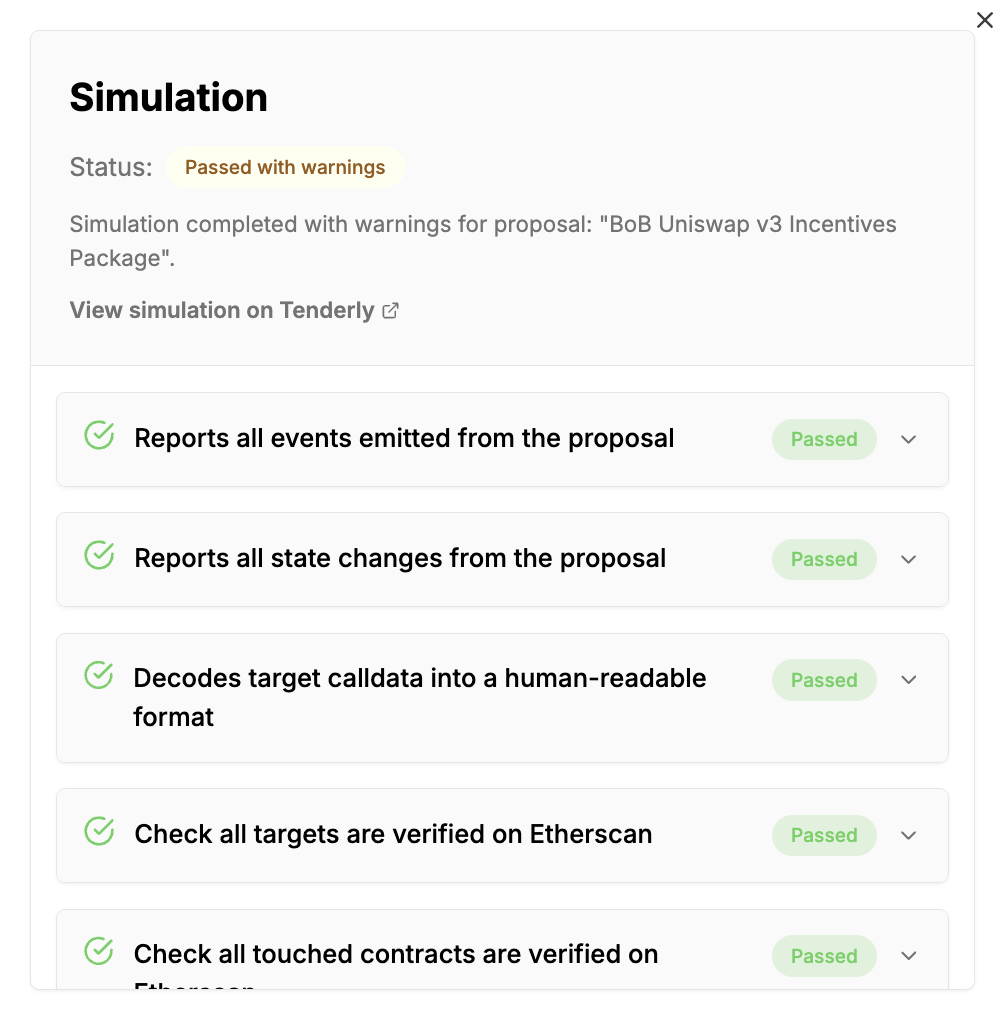Transaction Simulation & Verification
Deep simulation of DAO proposals using full governor and timelock context, with Tenderly support.
Transaction Simulation & Verification
When a proposal is submitted on-chain, it’s critical to ensure that what’s being executed is safe, transparent, and does exactly what the proposer intends. That’s where Transaction Simulation & Verification comes in.
This feature simulates the entire proposal execution before it’s ever executed—using the exact context of the governor, timelock, and the caller. The simulation runs via Tenderly, assuming it’s supported by the target chain, and provides deep insight into the behavior of the proposal.
Why Simulation Matters
Blockchain governance comes with irreversible consequences. Once a proposal passes, there’s no undo button. That’s why simulation and verification are vital:
- Catch unexpected side effects
- Verify all contract interactions
- Ensure calldata decodes as expected
- Establish a full audit trail of proposal behavior before it’s live
By integrating simulation into the governance process, DAOs increase safety and trust for all voters.
We run the same simulations when a proposal is in draft mode, giving the creator peace of mind before posting to the chain.
Below is a tiny screenshot of the feature.

What We Check
When a simulation runs, we verify a comprehensive set of checks.
✅ Reports All Events Emitted
We capture and display every single event emitted during proposal execution. This allows reviewers to:
- Confirm expected events (e.g. token transfers, role assignments)
- Detect unexpected or hidden contract behavior
✅ Reports All State Changes
We log all changes to contract storage, including:
- Updated variables
- New values for mappings or arrays
- Any modifications made during execution
This helps confirm that the proposal impacts state exactly as intended—nothing more, nothing less.
✅ Decodes Target Calldata
All target calldata is:
- Decoded into human-readable formats
- Matched against known ABI definitions
This gives voters and reviewers confidence in the intent of each call and makes it easier to spot misconfigured or malicious data.
✅ Verifies All Targets on Etherscan
Each target address in the proposal is:
- Checked for verified contract source code on Etherscan
- Flagged if any address points to an unverified or proxy contract
✅ Verifies All Touched Contracts on Etherscan
Even if the proposal doesn’t directly target them, we:
- Track every contract that gets touched
- Confirm verification status for those as well
Because malicious contracts often use
delegatecallor indirect hops to hide behavior—we catch those too.
✅ Checks for selfdestruct in Targets
We analyze each target contract and verify that:
- The bytecode does not include the
selfdestructopcode - If present, this may indicate dangerous or irreversible behavior
Proposals attempting to execute contracts with
selfdestructwill trigger a warning or fail simulation, depending on context.
✅ Checks for selfdestruct in Touched Contracts
Even contracts indirectly touched during execution are checked for selfdestruct. A warning is raised if any are found.
✅ Detects ETH Sent With Proposal Execution
We check whether:
- The proposal attempts to send ETH along with a call
- If so, it is clearly reported for transparency
This protects against silent ETH transfers or unintentional funding of contracts.
✅ Reports All ETH Balance Changes
We analyze ETH inflows and outflows for:
- Target contracts
- Touched contracts
- The timelock or DAO itself
This ensures ETH movement is deliberate and easy to audit.
Warnings
If something passes but raises a concern (e.g. unverifiable contracts or decoded calldata with unknown selectors), we warn but do not block. These warnings are meant to guide further manual review.
View on Tenderly
Each simulation links to the full Tenderly trace, including:
- Execution traces
- Gas usage
- Storage diffs
- Event logs
Under the Hood
- Simulations run as if the governor’s
execute()function is being called by the timelock, simulating the final step in the lifecycle of a proposal. - The full context includes the actual proposer, governor, timelock, and the current block timestamp.
- We simulate against forked mainnet state (where supported), providing real-world fidelity.
Who Benefits?
- DAO Voters get peace of mind knowing what they’re voting on
- Protocol Developers can debug and verify proposals before submission
- Governance Facilitators can provide richer documentation and transparency to the community

